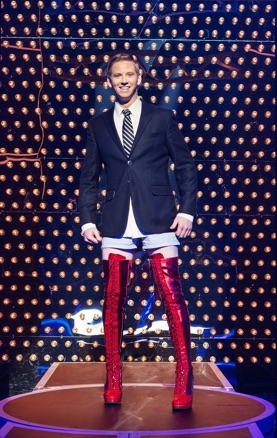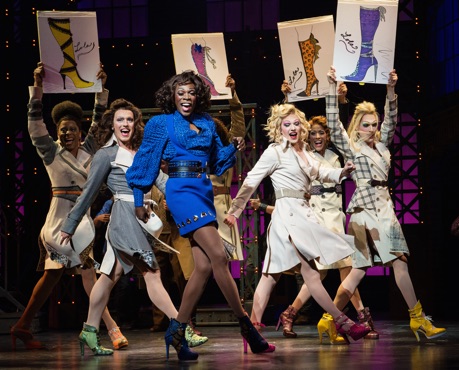Reviews 2015






✭✭✭✩✩
music and lyrics by Cyndi Lauper, book by Harvey Fierstein, directed by Jerry Mitchell
David Mirvish, Royal Alexandra Theatre, Toronto
June 28, 2015-May 15, 2016
Harvey Fierstein: “No one’s gay in this!”
The primary reason to see the musical Kinky Boots is Alan Mingo, Jr.’s fabulous performance as the drag queen Lola. It’s a performance that frequently goes over the top, but then it’s a role where “over the top” is one of its defining characteristics. With pop rock songs by Cyndi Lauper, the motto for the show could be “Girls (and Guys) Just Want To Have Fun”. The greatest flaw is the dull book by Harvey Fierstein. He never avoids a well-trodden plot turn if he can find one, laces the flimsy story with unearned sentiment and in-case-you-didn’t-get-it moralizing and whitewashes the material of gay content. In an upset, the show won the 2013 Tony Award for Best Musical over Matilda the Musical, coming to Toronto next summer, in a victory of fluff over substance, cliché over wit.
Kinky Boots is based on the 2005 British movie of the same name that was in turn inspired by real events surrounding the shoemaker W.J. Brooks, Ltd., in 1993. The family-owned maker of hand-sewn men’s shoes Northamptonshire, England, was about to go out of business but was saved by switching to manufacturing men’s fetish footwear. In the movie and the musical, W.J. Brooks is changed to Price and Son and the location shifted from the village of Earls Barton to the town of Northampton.

Structurally, the problem is that the show is basically over at the end of Act 1. Fierstein tries to manufacture a threat by having Nicola tell Charlie that there is a plan to turn the factory into condos, but Fierstein completely drops this idea in Act 2. Other than this artificial threat, all there is to bring us back to Act 2 in terms of plot is to see if Charlie’s new line of “kinky boots” succeed at a fashion show in Milan – but do we really think they won’t?
What fills Act 2, therefore, is lots of padding. Fierstein has Lola and Charlie bond over not being what their fathers wanted. He creates tension between Lola and the manly male workers of the factory, led by the lout Don (Daniel Williston) that eventually leads to a boxing match between the two and a lot of moralizing about what makes men real men and what women want in a man. As the deadline for Milan approaches, Fierstein has Charlie go on an entirely out of character tirade against the workers and against Lola where Charlie expresses prejudices that, if they had existed, Fierstein neglected to reveal in him anywhere previously in the show. Not only that, Fierstein has Charlie insist illogically that female models wear his kinky boots in Milan. Are we supposed to think that Charlie has suddenly forgotten what his niche market is?
As it turns out, Charlie’s bizarre, unprovoked rant is just another artificial plot device by Fierstein, this time to give the show the clichéd structure of turning dark before the dawn. Charlie gets to sing a big song of repentance, the workers get to show their forgiveness, Lola gets to show her forgiveness, saccharine flows like water and the show ends with a get together that has more to do with fantasy than reality. (How will ordinary workers wearing kinky boots help sales in Milan?) As if that weren’t enough, Fierstein gives us at least six one-line morals to draw from the show, the top one being “Accept someone for who they are”.
Kinky Boots intentionally goes where where previous musicals have gone before. Drag queens helping to save the day goes as far back as La Cage aux folles (1983) by Jerry Herman also with a book by Fierstein. Friendship between a regular guy and a transvestite already appeared in Billy Eliot (2005) by Elton John as does the notion of fathers coming to terms with their sons and of working class people who help support (to them) pansified pursuits like male ballet dancing or male transvestism. Kinky Boots even has a boxing scene like Billy Eliot. Lola is basically a younger, black Albin from La Cage and his backup dancers, the Angels, are just a reincarnation of Albin’s Cagelles.
The main difference in Kinky Boots is that the characters in drag are all straight. Lola reveals this in Act 2 and Fierstein has said outright about the show, “No one’s gay in this!”* Mirvish opened the show during Gay Pride Week, and many in the audience will be surprised to hear this. In fact, Billy Porter, who currently plays Lola on Broadway completely disagrees with Fierstein and says Lola has to be gay.†
Yet, as it is, it seems the show really is intended to be solely about people’s choice to wear what they want rather than anything more substantial. For all the flamboyance and bitchiness, Fierstein has deliberately desexualized Lola, the reason being that the producers want Kinky Boots to be regarded as a “family show”. This helps explain the lack of crude language, innuendo and double entendres – less than in one of Ross Petty’s Christmas pantos.
What is troubling is that an out writer like Fierstein should deliberately suppress any mention of gayness in the show. The word “gay” itself is never even spoken. Fierstein has Lola say that he is a drag queen, not a transvestite, but Fierstein, who ought to know better, has reversed the connotations of “drag queen”
(predominantly gay) and “transvestite” (predominantly straight) and erased the the gay connotation. Fierstein has Lola claim that he wears women’s clothes because he loves women so much, but this explanation is surely disingenuous. Why, when Lola puts on women’s clothes does he become flashier and sassier and his gestures more extravagant than any of the real women on stage? Like a gay drag queen, not like a transvestite, Lola becomes a hyped-up version of a female not simply a man dressed as a woman. If “No one’s gay in this!” then who are the straight Lola and his six straight Angels playing to in their club? Do the producers think that American family audiences can cope with men in frocks only if the men are not gay? If the show’s moral is “Accept someone for who they are”, it seems that motto applies only as long as sexuality is not involved.

Though Fierstein has updated the action from the 1990’s of the original story to the present with people using smartphones, Lauper’s songs all firmly recall the 1980s. No song echoes “Girl Just Want To Have Fun”, which was written in a faux-1950s style, but most of the ballads do recall “Time After Time” (1984) and “True Colors” (1986) in various ways. Aside from pseudo-English folk music to set the scene, a tango and a Beatleseque number in “Penny Lane” rhythm, Lauper’s songs are either soft pop ballads with piano, power ballads with wailing guitar or synth-heavy ’80 disco. She wins the audience over most easily with the last which form the finales of both acts. While Lauper is an expert at creating memorable hooks, she has difficulty writing memorable lyrics. Most of the Act 1 finale is taken up with variations on this line: “Everybody! Everybody! Everybody say Yeah! Yeah! Yeah!”
Given how energizing Lauper’s songs can be, it’s disappointing how unimaginative Jerry Mitchell’s choreography is. He does have to contend with David Rockwell’s set with its central moveable tower that makes much of the dancing feel cramped. His most effective number is the Act 1 finale where the cast dance on moving treadmills, but much of his inspiration, unfortunately, comes directly from the band OK Go’s famous and more impressive treadmill video for it’s 2006 song “Here It Goes Again”.‡
The musical, flimsy as it is, stands or falls based on the actor who plays the role of Lola, since Lola is the only multidimensional character in a show of cardboard cutouts. Triple-threat Alan Mingo, Jr. is wonderful in the role and takes the character though emotional highs, lows and doubts with crisp delivery, a powerful singing voice and gestural flair. Mingo generates such electricity on stage that the energy level drops whenever he’s not there. Like Billy Porter he seems to have ignored Fierstein’s notion that Lola is straight, and makes the character so hot we wonder if Charlie himself will fall for her. It does mean that Lola’s revelation that she is straight rings completely hollow in Act 2, an awkwardness even Mingo’s panache can’t fix.
Graham Scott Fleming has come a long way since I last saw him in Avenue Q at the Lower Ossington Theatre in 2013. Fleming can’t do much to enliven the exceedingly dull lines Fierstein has written, but he has a fine singing voice that conveys so much passion that Charlie’s singing self and speaking self seem like two different people. This is especially true of his soaring first act power ballad “Step One”. Fleming’s gift for physical comedy finally has an outlet in the Milan scene where Charlie fails spectacularly to be a model.
As Charlie’s second love interest Lauren, A.J. Bridel has a voice that sounds uncannily just like Lauper herself. She makes her big number “The History of Wrong Guys” quite amusing, but it would be much funnier if Mitchell had not had her pile on so much unnecessary mugging.
In other roles, Daniel Williston is more comic than threatening as the overweight yob Don. Vanessa Sears gradually reveals the difference in life priorities between Nicola and Charlie as her voice and posture become more rigid. And James Kall is a comforting presence as George, aide to Charlie’s father and the one person always looking out for Charlie’s best interests.
Kinky Boots is meant to be a feel-good show, but it is hard to feel good about a show written by a gay author and a gay ally composer who deliberately whitewash the show of gay references to increase its commercial viability. The talent of the performers is so great that it’s a pity the work they are performing is so formulaic and insubstantial. People who just want to check their brains at the door will be happy, but others may find the show makes them uneasy. This is a very peculiar time in history to dehomosexualize a musical (of all things) when only a gay presence can make sense of the main character and story.
©Christopher Hoile
*Signorile, Michelangelo, “Harvey Fierstein On 'Kinky Boots,' Working With Cyndi Lauper And His Show's Big Surprise”, Huffington Post, May 17, 2013 (www.huffingtonpost.com/2013/05/17/harvey-fierstein-kinky-boots_n_3292504.html).
†Halterman, Jim, “Billy Porter’s “Kinky Boots” Character is Fierce, Sexy… and Gay”, The Backlot, May 30, 2013 (www.thebacklot.com/billy-porter-shines-as-kinky-boots-lola-and-a-tony-could-be-next/05/2013).
‡Video for “Here It Goes Again” by OK Go, 2006 (www.youtube.com/watch?v=dTAAsCNK7RA).
Note: This review is a Stage Door exclusive.
Photos: (from top) Cast of Kinky Boots; Graham Scott Fleming as Charlie Price; Alan Mingo, Jr. as Lola (in blue) with the Angels. ©2015 Cylla von Tiedemann.
For tickets, visit www.mirvish.com.
2015-06-29



Kinky Boots





